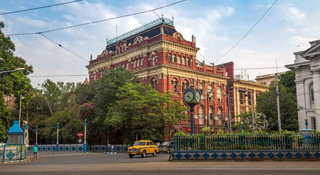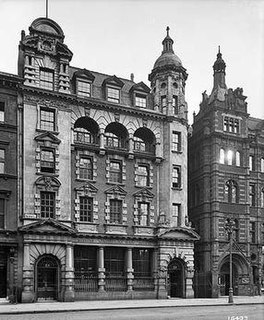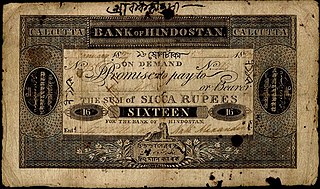| Type | Public sector |
|---|---|
| Industry | Banking, Insurance, Capital Markets and allied industries |
| Founded | 1786 |
| Founder | East India Company |
| Defunct | 31 March 1791 |
| Fate | Defunct |
| Headquarters | , |
Number of locations | Bengal Presidency |
Area served | India |
| Products | Deposits, Personal Banking Schemes, C & I Banking Schemes, Agri Banking Schemes, SME Banking Schemes |
| Services | Loans, Deposits |
The General Bank of India was a bank founded in the 18th century and lasted till 1791. [1] [2]
The Bank is one of the five oldest Banks in India, along with the Bank of Hindostan. [1] [2]
In the 18th century, Calcutta had become a centre of trade and commercial activities of the East India Company. Most of British commercial agencies, businesses, export houses and private industry were headquartered in Calcutta. All of these businesses were staffed and managed by British expatriates in India. A need was felt for a bank which would cater to the needs of these people. As a result, the General Bank of India was founded in 1786 in Calcutta. [1] [3] [2]
The bank was staffed by employees, who were mostly British nationals and drawn mainly from the East India Company. [1] [2]
The bank is largely notable for being the fifth oldest bank in India. [3] [1] [2]
The bank also played a major role in making the city of Calcutta, the economic and financial centre of British India. Calcutta thus came to be known as the second city of the British Empire. [4] [2]

Kolkata is the capital of the Indian state of West Bengal. Located on the eastern bank of the Hooghly River, the city is approximately 80 km (50 mi) west of the border with Bangladesh. It is the primary business, commercial, and financial hub of Eastern India and the main port of communication for North-East India. According to the 2011 Indian census, Kolkata is the seventh-most populous city in India, with a population of 45 lakh (4.5 million) residents within the city limits, and a population of over 1.41 crore (14.1 million) residents in the Kolkata Metropolitan Area. It is the third-most populous metropolitan area in India. In 2021, the Kolkata metropolitan area crossed 1.5 crore (15 million) registered voters. The Port of Kolkata is India's oldest operating port and its sole major riverine port. Kolkata is regarded as the cultural capital of India. Kolkata is the second largest Bengali-speaking city after Dhaka. It has the highest number of nobel laureates among all cities in India.

State Bank of India (SBI) is an Indian multinational public sector bank and financial services statutory body headquartered in Mumbai, Maharashtra. SBI is the 49th largest bank in the world by total assets and ranked 221st in the Fortune Global 500 list of the world's biggest corporations of 2020, being the only Indian bank on the list. It is a public sector bank and the largest bank in India with a 23% market share by assets and a 25% share of the total loan and deposits market. It is also the fifth largest employer in India with nearly 250,000 employees. On 14 September 2022, State Bank of India became the third lender and seventh Indian company to cross the ₹ 5-trillion market capitalisation on the Indian stock exchanges for the first time.

Indian Bank is an Indian public sector bank, established in 1907 and headquartered in Chennai. It serves over 100 million customers with 39,734 employees, 5,721 branches with 5,428 ATMs and Cash deposit machines. Total business of the bank has touched ₹1,010,000 crore (US$130 billion) as on 31 March 2022.

The Bengal Presidency, officially the Presidency of Fort William and later Bengal Province, was a subdivision of the British Empire in India. At the height of its territorial jurisdiction, it covered large parts of what is now South Asia and Southeast Asia. Bengal proper covered the ethno-linguistic region of Bengal. Calcutta, the city which grew around Fort William, was the capital of the Bengal Presidency. For many years, the Governor of Bengal was concurrently the Viceroy of India and Calcutta was the de facto capital of India until 1911.
Modern banking in India originated in the mid of 18th century. Among the first banks were the Bank of Hindustan, which was established in 1770 and liquidated in 1829–32; and the General Bank of India, established in 1786 but failed in 1791.
Kolkata is the capital of the Indian state of West Bengal and is located in eastern India on the east bank of the River Bhagirathi-Hooghly (Ganga). The city was a colonial city developed by the East India Company and then by the British Empire. Kolkata was the capital of the British Indian empire until 1911, when the capital was relocated to Delhi. Kolkata grew rapidly in the 19th century to become the second most important city of the British Indian Empire. This was accompanied by the development of a culture that fused Indian philosophies with Victorian tradition.
The Mercantile Bank of India, London and China, later Mercantile Bank Ltd, was an Anglo-Indian bank with business focus in the Far East. It was founded in Bombay in 1853 as the Mercantile Bank of Bombay; and later in 1857 was renamed to Mercantile Bank of India, London, and China with London as its headquarters.

Allahabad Bank was an Indian nationalised bank with its headquarters in Kolkata, India. Founded in Allahabad in 1865 and nationalized by the government of India in 1969, the bank provided banking and financial services for 155 years until it was merged with Indian Bank in 2020. It was the oldest still running joint stock bank in India until it's merger.

B. B. D. Bagh, formerly called Tank Square and then Dalhousie Square, is the shortened version for Benoy-Badal-Dinesh Bagh. It is the seat of power of the state government, as well as the central business district of Kolkata in Kolkata district in the Indian state of West Bengal.

Kolkata is the prime business, commercial and financial hub of eastern India and the main port of communication for the North East Indian states. Kolkata is the third largest economy in India after Mumbai and Delhi. Kolkata, with a GDP (PPP) of $150.1 billion is home to India's oldest, stock exchange company (bourse) – The Calcutta Stock Exchange. Kolkata is home to many industrial units operated by large public- and private-sector corporations; major sectors include steel, heavy engineering, mining, minerals, cement, pharmaceuticals, food processing, agriculture, electronics, textiles, and jute.

The historic overseas bank was established in London in 1828 as Leslie & Grindlay, agents and bankers to the British army and business community in India. Banking operations expanded to include the Indian subcontinent, the Middle East and elements of Africa and Southeast Asia. It was styled Grindlay, Christian & Matthews in 1839, Grindlay & Co from 1843, Grindlay & Co Ltd from 1924 and Grindlays Bank Ltd in 1947 until its merger with the National Bank of India.

Bank of Hindostan (1770–1832), a now defunct bank, is considered as among the first modern banks in Colonial India.
The Bank of Bombay was the first bank founded in India, in 1720, and lasted until 1770.
The General Bank of Bengal and Bihar was a bank founded in the year 1773 in British India. The bank was the third oldest bank in India. The bank became defunct March 31st, 1775.
The Bengal Bank was a bank founded in the year 1784 in British India. The bank was the fourth oldest bank in India.
The Carnatic Bank was a bank founded in the year 1788 in British India. The bank was the sixth oldest bank in India.
The Union Bank was a bank founded in the year 1828 in British India by Prince Dwarkanath Tagore. The bank was the eleventh oldest bank in India.
The Commercial Bank was a bank founded in the year 1819 in British India. The bank was the eighth oldest bank in India.
The Calcutta Bank was a bank founded in the year 1824 in British India. The bank was the ninth oldest bank in India.
The Bank of Mirzapore (1835) was a bank founded in the year 1835 in British India. The bank was the fourteenth oldest bank in India.